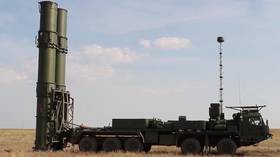NASA ASTRONAUTS ON RT’S SPACEWALK 360: ‘LIKE BEING IN SPACE AGAIN’
TOULOUSE, OCTOBER 19, 2017—NASA astronauts, as well as other guests and speakers at the 30th Planetary Congress, organized by the Association of Space Explorers (ASE), shared their impressions of RT’s Spacewalk 360 project, which presented the first-ever panoramic video filmed in open space—a collaborative effort between RT, Roscosmos State Corporation and Energia Rocket and Space Corporation.
Commenting on the world’s first-ever panoramic video filmed in open space, NASA astronaut Scott Altman, commander of the last two Hubble Space Telescope service missions, said: “Wow, it reminds me of being there. Very good. You get a little wobbly, like being in space again, the feeling of zero G.”
American astronauts also discussed the potential for using the RT video to prepare for future space missions, with Altman adding: “I think there are a lot of applications. One is clearly training, getting people used to what it’s going to be like in the perspective that you will have. But there is also a huge value in the entertainment: to be able to give other people the experience that you have on orbit. You have that sharing of that event, so you are very impressive.”
Japanese astronaut Soichi Noguchi, head of ASE Asia, noted: “It really looks real. I see the space station; I see the Soyuz. And of course I see the big Earth…It’s very well done! I think the best use is to inspire young generations, school kids and students to feel the emotion: a little bit of anxiety, a little bit of excitement, and a little bit of happiness to go outside the station and to do the spacewalk. And hopefully [it] motivates youngsters to go to space.”
Noguchi also stressed that Spacewalk 360 is superior to existing methods of using VR technologies for training astronauts. “Training? We do have a virtual reality vision system for a very long time, but not as good as this one! The important thing is that you put on a virtual reality, you turn around, you find the necessary equipment around you. It can be used both for the spacewalk and also for the internal science experiment. If you have to do the complicated operation it is good to have this type of device. I think all the space agencies, not just Japan, but in USA, Russia, Canada, China, they are very interested in using this type of new technology—virtual reality, mixed reality or augmented reality.”
NASA astronaut and author of the New York Times bestseller ‘Sky Walking: An Astronaut’s Memoir,’ Thomas Jones, also shared his impressions of the video. “I think what this kind of technology does is it enables you to voyage to a place like a space station, perhaps into the surface of the moon. We actually could transmit images back from Mars and then allow anyone back here—a student or a scientist—to walk around the Martian landscape. And I think that is the great use of the technology. [It] will be as that it takes you into space almost as if you could really make the journey over there. You experience it, you can look around, behind the boulder, crawl over the module of the space station. It’s quite good. Very impressive!”
Michael Lopez-Alegria, the NASA astronaut who holds the US record for the number of space walks completed, added: “The idea of having a VR experience outside the spacecraft is great. And it could be used for training as well [...] the images here, they are real images. Congratulations, well done!”
Jean-Yves Le Gall, president of the French National Center for Space Research (CNES), noted the superiority of the experience over Hollywood movies about space. “You see, young people have probably seen many movies about space: ‘Gravity,’ ‘Interstellar,’ etc. But here it is: the reality. Sometimes I have some regrets because in these blockbusters made by Hollywood it is not exactly the reality. This is the reality; this is very interesting.”
Back In November 2016, RT became the first media outlet in history to ‘send’ viewers to space, providing unparalleled panoramic images of Earth as seen from aboard the International Space Station (ISS). Mashable commented that the video “gets you as close as possible to the experience of actually being aboard the ISS and looking down on our home planet.” The video received enthusiasm and praise not just from internet users, but also from former NASA astronauts and well-known public figures. Former astronauts Terry Virts and Clayton Anderson said the RT360 video was “one of the very best,” and American director Oliver Stone compared it to a videogame. Chelsea Clinton, daughter of former US presidential candidate Hillary Clinton, posted the video on her Twitter and Facebook, writing: “Very cool. First panoramic view of Earth can be seen from this 360-degree video shot aboard the International Space Station."
In 2015, RT became one of the first international media outlets to start producing news content in the immersive 360-degree format and now boasts one of the largest original 360 content libraries, with more than 150 videos. RT’s 360 content is available on Facebook, YouTube and the RT360 mobile app (download at Google Play, App Store and Oculus Store).
To change the viewing angle when watching on a PC, hold the left mouse button and move the cursor in the desired direction. On a smartphone, simply move the device.












